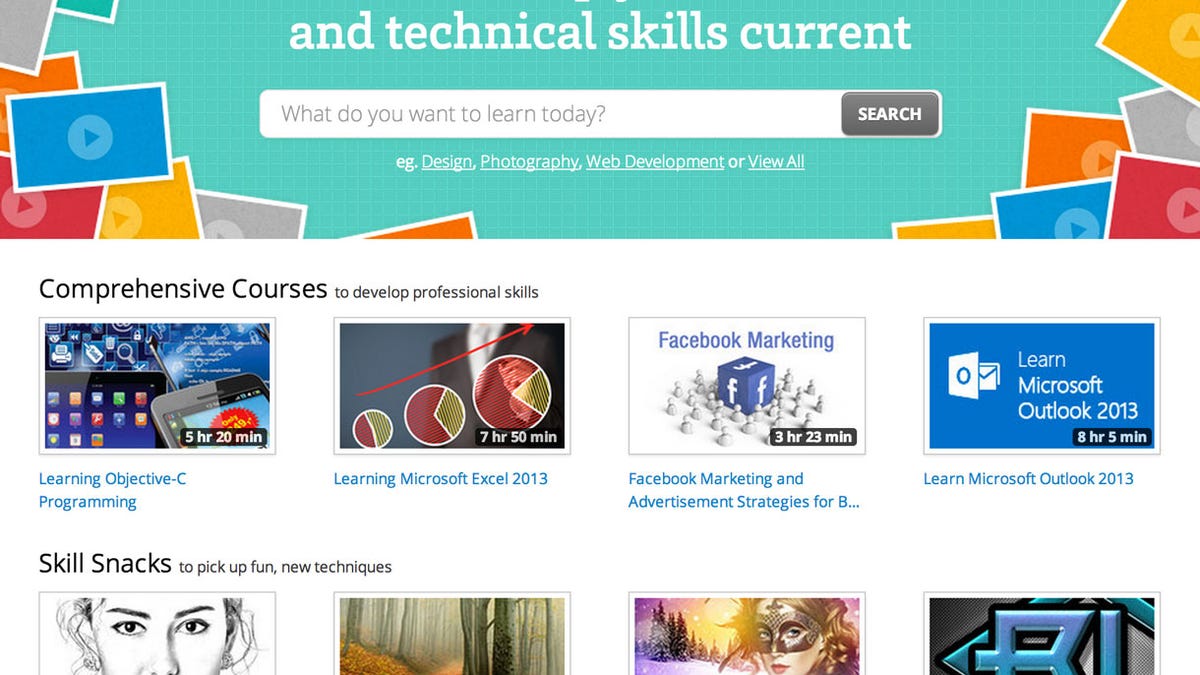With Skillfeed, Shutterstock aims to rework online training
The stock-art company hopes to profit by connecting makers of instructional videos with professionals who'll pay $19 a month to watch them.

Shutterstock has launched a new subscription service called Skillfeed designed to connect professionals who need to learn how to use their computers with creative types who want to make videos that do the teaching.
With the $19-per-month service, subscribers can watch as many videos as they want, either longer-form courses or shorter "snacks" good for smaller periods of free time, said David Fraga, Skillfeed's general manager. And content contributors get paid: Shutterstock keeps 70 percent of the proceeds, but the rest is divided among all contributors based on what fraction their videos were of the total time watched.
Online education is quite a departure for the New York-based company, whose core business is selling stock-art photos to ad agencies, brochure designers, and others who need to drop graphics into their work. Shutterstock is one of the large "microstocks" that revolutionized stock-art purchasing by combining a global photographer talent pool with Internet sales to yield significantly lower licensing costs for customers.
But fundamentally, the move isn't totally alien. For one thing, it's still connecting creative types with buyers across the globe.
"We wanted to create another high-volume marketplace, to take what we learned from Shutterstock and create something else that had the same sort of network effect," where it works better the more people join, said Shutterstock founder and Chief Executive Jon Oringer. Shutterstock has lots of experience knowing "how make two sides of a marketplace happy," so buyers and sellers both are satisfied, he said.
Although Skillfeed has been live for a couple months, Shutterstock hasn't publicized it until now. Initially, the company hopes to get the attention those with whom it already has a relationship -- photographers or videographers hoping to learn new methods, or stock-art buyers wanting new design approaches.
It remains to be seen whether Shutterstock will be able to spin Skillfeed into a positive feedback loop of contributors and subscribers. It certainly isn't alone in the market for instructional videos, which the tech industry long before streaming video on the Internet made it so much more feasible. YouTube has countless tutorials available for free, albeit with varying quality.
It's not even the first subscription service, though one clear rival, Lynda.com, charges $25 a month for its service.
Skillfeed also will have some work to do signing up contributors from the existing pool. For example, George Jardine, who sells Adobe Photoshop and Lightroom instructional videos and runs training workshops, didn't seem interested.
"The vast majority of people looking for video instruction are looking for a fast-food lunch. Something that fills their tummy very cheaply, doesn't cost much, and most importantly, doesn't take much of their precious time," he said. "I cater to an entirely different audience, with an entirely different approach. My videos are for the thinking photographer, who is devoted to spending the time and brain power to dig into their subject and truly understand it."
Shutterstock thinks Skillfeed as worth the money, though, especially compared to the cost of books or in-person workshops. And although it fended off repeated questions about how big it thinks the business could become, the company clearly doesn't see it as a small niche.
"Technology changes quickly, and to understand most recent software and techniques, you have to be current," Fraga said. "This is something that applies to tens of millions of people around the world."
And Oringer, who watched the professional photography business expand dramatically with the arrival of countless part-time stock-art photographers, thinks there's room for a lot more instructional video creators. "There are plenty of people out there with a screen-scraper who'll teach somebody how to do something," he said.
Skillfeed will try to show the good videos, initially judged by popularity. The company also plans to add forums. "We see that kind of interactivity in the future," Fraga said.
To start with, Skillfeed's content skews toward the photo and design world, where Adobe's Creative Suite (and perhaps tomorrow its Creative Cloud) is king of the mountain. But it's going after a much broader market -- people learning new programming languages, architects learning AutoCAD, number crunching with Excel spreadsheets, or search engine optimization, for example.
"The point is people are looking to be self-taught and are looking to the Web to retool their skills -- not just creative skills but any skills that help you be a digital professional, the things that help you be successful in your career," Fraga said.

